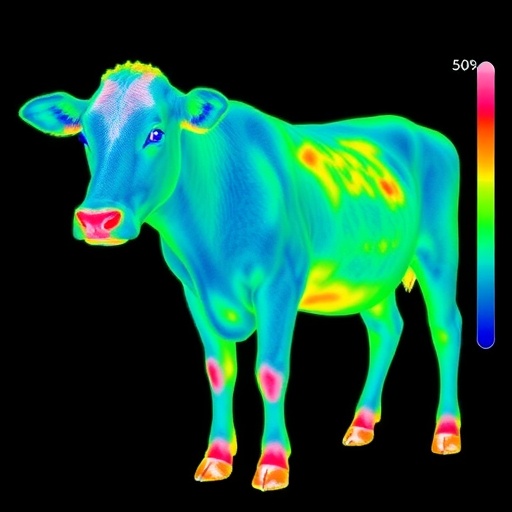In a groundbreaking advancement in veterinary science, researchers at Osaka Metropolitan University have harnessed the power of artificial intelligence (AI) combined with infrared thermography to revolutionize the way cattle body temperatures are monitored. This innovative approach addresses long-standing challenges associated with traditional methods and opens new horizons for animal health assessment and stress monitoring. By integrating AI-driven segmentation techniques with high-resolution thermal imaging, the team has paved the way for continuous, non-invasive, and highly accurate detection of temperature variations specifically targeting the eyes and muzzles of calves.
Conventional veterinary practices for measuring body temperature in livestock primarily rely on rectal thermometers, a method that, despite its reliability, imposes considerable stress on the animals and does not facilitate ongoing monitoring. Moreover, rectal temperature readings are typically sporadic, offering only snapshots of physiological states rather than comprehensive temporal profiles. Recognizing these limitations, the research team turned to infrared thermography, a technique that measures surface temperatures remotely through thermal cameras, reducing the need for direct contact. However, the implementation of infrared thermography has its own constraints, notably its dependence on manual setting of regions of interest (ROI) in the imaging data, which introduces variability and hampers consistent long-term monitoring.
To overcome these obstacles, Assistant Professor Sueun Kim and colleagues at the Graduate School of Veterinary Science employed advanced AI segmentation algorithms to automatically and precisely identify critical thermal regions, such as the eyes and nose, within continuous infrared video footage. Their approach utilizes convolutional neural networks trained to differentiate these anatomical zones amidst complex visual data, ensuring that temperature measurements are systematically derived from consistent spatial locations across time. This automated segmentation eliminates observer bias and dramatically improves data reliability, enabling high-resolution thermal pattern mapping that was previously unattainable.
.adsslot_fZjRb5cTKX{ width:728px !important; height:90px !important; }
@media (max-width:1199px) { .adsslot_fZjRb5cTKX{ width:468px !important; height:60px !important; } }
@media (max-width:767px) { .adsslot_fZjRb5cTKX{ width:320px !important; height:50px !important; } }
ADVERTISEMENT
The experimental framework involved collecting thermal data from eleven calves through infrared cameras capable of capturing subtle temperature fluctuations. Simultaneously, the team recorded synchronized video to provide comprehensive datasets for AI processing. By analyzing nearly 200 unique thermal change patterns extracted from the segmented ROIs, the researchers discovered reproducible and stable temperature profiles. Notably, both eyes and muzzles exhibited temperature shifts clustering within the top 10% to 30% of their respective ranges, highlighting regions as bio-indicators of physiological changes.
The intricate statistical analysis applied provided compelling evidence that temperature variations in specific facial areas correlate with underlying metabolic and homeostatic processes. As body temperature reflects an animal’s health and stress status, this AI-enhanced thermography system has profound implications. It enables near-continuous thermal monitoring without the need for invasive instrumentation or labor-intensive data collection. This is a crucial step forward for animal welfare and precision livestock farming, promising earlier detection of health anomalies, such as inflammation or infection, and more refined assessment of environmental stress impacts.
One of the notable achievements of this study lies in its capacity to generate robust datasets amenable to complex statistical modeling and pattern recognition. The automated identification of ROIs opens pathways for integrating thermal data with physiological and behavioral metrics, potentially enabling predictive algorithms that can preemptively flag health issues before clinical symptoms become overt. Additionally, the use of AI catalyzes scalability; such systems can be deployed across large herds, overcoming bottlenecks inherent in traditional temperature monitoring methods.
The adoption of this technology aligns with the broader trend in the life sciences towards non-invasive, continuous biometric monitoring utilizing AI as a facilitator. Thermal imaging enhanced by AI segmentation offers a powerful tool that transcends mere temperature measurement, providing spatially resolved maps of temperature distribution that reveal subtle changes indicative of stress responses or disease states. This capability is transformative, particularly in livestock industries where early intervention and stress minimization directly translate into improved productivity and animal welfare.
Assistant Professor Kim emphasized the transformative potential of this research, noting that it lays the groundwork for a new paradigm in veterinary diagnostics and animal management. “Our methodology allows us to detect consistent temperature patterns without direct contact, significantly reducing animal stress and enabling various sophisticated analyses,” Kim stated. She underscored the importance of this non-invasive technology for the future, envisioning its role in precision health monitoring, welfare assessments, and potential integration with other sensor modalities for holistic livestock management.
The implications of AI-enhanced infrared thermography extend beyond cattle and could inspire applications in diverse animal populations, from companion animals to wildlife monitoring. This study exemplifies how interdisciplinary collaboration—melding veterinary science, computer vision, and data analytics—can yield innovative solutions to age-old problems. The ability to remotely monitor vital signs reliably and continuously is poised to catalyze advancements in veterinary epidemiology, animal behavior studies, and the management of zoonotic diseases.
Moreover, this research contributes to the growing corpus of AI-driven applications in agriculture and veterinary medicine, where the optimization of animal health and welfare intersects with economic sustainability. Accurate thermal profiling can aid farmers in identifying stress-inducing environmental factors, fine-tune husbandry practices, and ultimately reduce the dependency on pharmaceuticals through early intervention. The broader vision envisages smart farming ecosystems where sensor networks and AI collectively enhance decision-making processes, elevating standards across the livestock industry.
Published in the peer-reviewed journal BMC Veterinary Research, the study brings a methodological innovation that combines advanced imaging technologies with AI to redefine biomedical data acquisition in veterinary contexts. The researchers’ commitment to open science and transparent reporting ensures that this approach can be adopted and further refined by the global scientific and farming communities. Their work exemplifies how foundational research can translate swiftly into practical tools with substantial real-world impact.
The study underscores the necessity of continued technological integration in veterinary health monitoring, advocating for further exploration into automated image analysis and machine learning models that can expand interpretative power. Future research directions may include exploring temperature pattern correlations with specific diseases, stressors, or developmental stages, as well as adapting the AI models for other species and environmental conditions. The fusion of AI with infrared thermography thus represents a promising frontier in animal health sciences.
Subject of Research: Animals
Article Title: AI-enhanced infrared thermography for reliable detection and spatial mapping of temperature patterns in calf eyes and muzzles
News Publication Date: 15-Jul-2025
Web References:
http://dx.doi.org/10.1186/s12917-025-04919-1
Image Credits: Osaka Metropolitan University
Keywords: Artificial intelligence, infrared thermography, veterinary science, cattle health monitoring, temperature mapping, non-invasive sensing, machine learning, livestock welfare, precision farming
Tags: advancements in veterinary technologyAI in veterinary scienceAI-driven thermal imaging techniquescontinuous temperature detection in calveshigh-resolution thermal imaging for animalsinfrared thermography for livestockinnovative approaches in animal welfarenon-invasive animal health assessmentovercoming limitations of rectal thermometersprecise temperature pattern detection in calvesreducing stress in livestock monitoringtemperature monitoring in cattle





